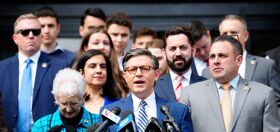
America’s founding fathers envisioned a nation free of monarchical tyranny – a nation where all citizens received the right to vote. In doing so, those revolutionary thinkers hoped to ensure the government spoke for the people. As any historian will tell you, however, that independent theory didn’t exactly hold up. America’s founders were looking after their own – white, Christian, straight and wealthy. Fuck rule of law. Land owners were the law.
Generations – and a Civil War – later, America extended nominal rights to black and, eventually, women. Despite these moves, it would take an entire civil rights movement to overturn racist Jim Crow laws, such as literacy tests and poll taxes. Now that all Americans have the right to vote, does America’s voting system guarantee all voters their rights? Don’t count on it.
Of all the milestone years in gay history, 1996 proved to be one of the most volatile, disappointing and judicially satisfying. On the federal front, the American Congress failed to pass the Employment Non-Discrimination Act, the successor to 1974’s so-called Gay Rights Bill. Though ENDA’s demise disappointed many, gay rights did get a boost in 1996, when the United States Supreme Court ruled on Romer v. Evans, in which the Court struck down Colorado’s anti-gay Amendment 2. That particularly anti-gay piece of legislation read thus:
Neither the state of Colorado, through any of its branches or departments, nor any of its agencies, political subdivisions, municipalities or school districts, shall enact, adopt or enforce any statute, regulation, ordinance or policy whereby homosexual, lesbian or bisexual orientation, conduct, practices or relationships shall constitute or otherwise be the basis of, or entitle any person or class of persons to have or claim any minority status, quota preferences, protected status or claim of discrimination.
In layman’s terms, Colorado citizens voted that gays should not – and could not – use the law to protect themselves against homophobic acts or discrimination. Race, religion and gender were totally acceptable. Gays? They just wanted to be a protected class – the same argument currently put forth by Focus on the Family and other groups fighting hate crime legislation.
While the government worked to deny gays equal employment access, a Gallup poll reported that 84% of Americans believed gays deserve “equal rights in terms of job opportunities”. How could politicians – the men and women we elect – vote against gay employment rights? And, despite America’s liberal promise of equality under the law, Coloradan lawmakers explicitly injected discrimination into their state’s constitution. And did so completely legally with the help of one of America’s essential political mechanisms: our voting system.
How about we take this to the next level?
Our newsletter is like a refreshing cocktail (or mocktail) of LGBTQ+ entertainment and pop culture, served up with a side of eye-candy.
America’s political system relies on a simple, yet troublesome, voting system called single-member district plurality, which is most often referred to as a first past the post system. Here’s how it work: every citizen casts one vote for one candidate in their district. Unlike playground games where majority rules, America’s first past the post winners need not win an overwhelming bulk of votes. Rather, a successful political candidate must only win the most votes first. Confused? Perhaps a fictional example will help clear things up.
Let’s pretend we have three candidates running in the Illinois gubernatorial election. We’ve got Jerry Falwell on the right, Lisa Kudrow on the left and Kermit the frog somewhere in the middle. Forty percent of voters lend Falwell’s “traditional” politics their support, 35% liked Lisa Kudrow’s work on Friends and trust she’ll live up to their political expectation. The young at heart, meanwhile, throw Kermit their votes, giving him 25% of the electoral pie. Though 60% of voters may detest Falwell and his politics, the late Reverend becomes Governor. Forty percent of voters’ political wishes will come true. The majority of voters, meanwhile, are left in the proverbial dust. Is this democracy? Yes. Does it guarantee people’s voices are heard? Obviously not. It does, however, guarantee undemocratic constraints on our government’s anatomy.
There are currently forty-eight national political parties in America, but only the Republican and Democratic parties hold any real sway. Why? Well, let’s take another look at the fictional vote above. If the media hypes up Falwell and Kudrow’s respective campaigns, but dogs Kermit’s hopes, most voters will consider Falwell and Kudrow the front runners. Thus, they’re more likely to to vote for one of them lest their vote be wasted on Kermit. If you need another example, just think of the 2000 election: Bush, Gore, Nader. Sure, you may have adored Ralph Nader, but wise voters knew he’d never win. Those who voted for him, some say, took votes from Gore and helped Bush “win” the election. This tactical voting leads to what’s called Duverger’s Law.
Named for its founding theorist, Maurice Duverger, Duverger’s Law holds that first past the past always leads to a two-party system. No matter how many political parties register in any given country, two will dominate. Duverger writes:
Elections determined by a majority vote on one ballot literally pulverize third parties (and would do worse to fourth or fifth parties, if there were any; but none exist for this very reason). Even when a single ballot system operates with only two parties, the one that wins is favored, and the other suffers. The first one is over-represented–its proportion of seats is greater than its percentage of the votes-while the party that finishes second is usually under-represented–its proportion of seats is smaller than its percentage of the votes.
Duverger’s Law may hurt some political outcasts, but it strengthens those with a strong popular foundation. And trust those parties – particularly the GOP – know how to use the law to their advantage. And our disadvantage.
Bolstered by social conservatives, the Republican party successfully waged a series of campaign wars that helped them take control of Congress, birthed Amendment 2, killed ENDA and sparked America’s protracted Culture Wars. To completely understand how plurality voting cuts queers out, we first have to take a look at the development of America’s post-war politics, the rise of anti-gay politicos and their pro-gay counterparts.
Surf on over next Wednesday for part two of our electoral examination.




















GranDiva
Hmm.
Interesting, but do you think that we gays will stop long enough to try and comprehend all of this stuff thoroughly before we flip back to the pictures of the cute boys?
I think that’s asking a bit much.
Aaron
Great, thoughtful analysis of the flaws in the electoral system, though curious to find out if (and why) homosexuality has been less polarizing in other first-past-the-post systems… or is it that the electoral system is merely an enabler of America’s peculiar brand of homophobic politicians…